Contemporary Chinese Pulse Diagnosis®
 Dragon Rises College of Oriental Medicine is best known for Contemporary Chinese Pulse Diagnosis®. This extensive and comprehensive diagnostic technique is an ancient art which studies the twenty-eight pulses found on the wrists. Each position tells us something about every organ, the function of the organ and how the organs contribute to the body by way of Qi and blood, as well as the health of tissue, fluids, and the homeostatic process within the body.
Dragon Rises College of Oriental Medicine is best known for Contemporary Chinese Pulse Diagnosis®. This extensive and comprehensive diagnostic technique is an ancient art which studies the twenty-eight pulses found on the wrists. Each position tells us something about every organ, the function of the organ and how the organs contribute to the body by way of Qi and blood, as well as the health of tissue, fluids, and the homeostatic process within the body.
Pulse diagnosis reveals critical information that can greatly alter treatment strategy, and the most incredible aspect of this diagnostic technique is its preventative abilities. A thorough examination of, and diagnosis using, the pulse can read serious disease potential one to three years in advance, as well as help the practitioner to understand acute issues that may also be occurring now or contributing to future problems.


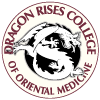
 Acupuncture is a traditional Chinese medical technique for unblocking Qi, practiced in China for more than 2000 years. Qi is an energy believed to flow through the body along fourteen main pathways, called meridians, and its harmonious movement relies on the balance of yin and yang energies in the body. When yin and yang are in harmony, Qi flows freely, and a person is healthy. When there is an obstruction of Qi along one of the meridians, or an imbalance of yin and yang, a person is sick, diseased, or suffering from injury.
Acupuncture is a traditional Chinese medical technique for unblocking Qi, practiced in China for more than 2000 years. Qi is an energy believed to flow through the body along fourteen main pathways, called meridians, and its harmonious movement relies on the balance of yin and yang energies in the body. When yin and yang are in harmony, Qi flows freely, and a person is healthy. When there is an obstruction of Qi along one of the meridians, or an imbalance of yin and yang, a person is sick, diseased, or suffering from injury.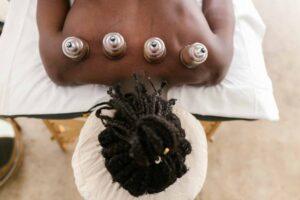 Cupping refers to an ancient Chinese practice in which a cup is applied to the skin and the pressure in the cup is reduced (by using change in heat or by suctioning out air), so that the skin and superficial muscle layer is drawn into and held in the cup. In some cases, the cup may be moved while the suction of skin is active, causing a regional pulling of the skin and muscle.
Cupping refers to an ancient Chinese practice in which a cup is applied to the skin and the pressure in the cup is reduced (by using change in heat or by suctioning out air), so that the skin and superficial muscle layer is drawn into and held in the cup. In some cases, the cup may be moved while the suction of skin is active, causing a regional pulling of the skin and muscle.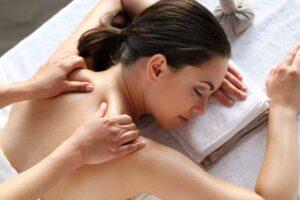 Tuina (Tui Na) is an Oriental Bodywork Therapy that has been used in China for 2,000 years. Tuina uses the traditional Chinese medical theory of the flow of Qi through the meridians as its basic therapeutic orientation. Through the application of massage and manipulation techniques, Tuina seeks to establish a more harmonious flow of Qi through the system of channels and collaterals, allowing the body to heal itself naturally.
Tuina (Tui Na) is an Oriental Bodywork Therapy that has been used in China for 2,000 years. Tuina uses the traditional Chinese medical theory of the flow of Qi through the meridians as its basic therapeutic orientation. Through the application of massage and manipulation techniques, Tuina seeks to establish a more harmonious flow of Qi through the system of channels and collaterals, allowing the body to heal itself naturally.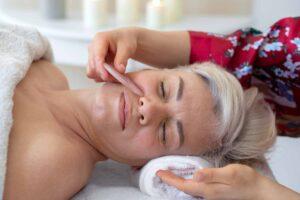 Gua Sha is an Asian healing technique used in both the clinical setting and in the home. It involves palpation and cutaneous stimulation where the skin is pressured, in strokes, by a round-edged instrument; that results in the appearance of small red petechiae called ‘sha’, that will fade in 2 to 3 days. Raising Sha removes blood stagnation considered pathogenic, promoting normal circulation and metabolic processes. The patient experiences immediate relief from pain, stiffness, fever, chill, cough, and nausea. Gua Sha is valuable in the prevention and treatment of acute infectious illness, upper respiratory and digestive problems, and many other acute or chronic disorders.
Gua Sha is an Asian healing technique used in both the clinical setting and in the home. It involves palpation and cutaneous stimulation where the skin is pressured, in strokes, by a round-edged instrument; that results in the appearance of small red petechiae called ‘sha’, that will fade in 2 to 3 days. Raising Sha removes blood stagnation considered pathogenic, promoting normal circulation and metabolic processes. The patient experiences immediate relief from pain, stiffness, fever, chill, cough, and nausea. Gua Sha is valuable in the prevention and treatment of acute infectious illness, upper respiratory and digestive problems, and many other acute or chronic disorders.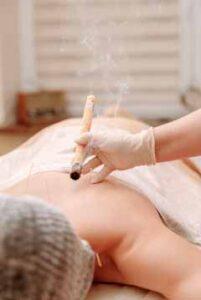 Moxibustion is a traditional Chinese medicine technique that involves the burning of mugwort, a small, spongy herb, to facilitate healing. The purpose of moxibustion, as with most forms of traditional Chinese medicine, is to strengthen the blood, stimulate the flow of qi, and maintain general health. In traditional Chinese medicine, moxibustion is used on people who have a cold or stagnant condition. In Western medicine, moxibustion has successfully been used to turn breech babies into a normal head-down position prior to childbirth, rescue people from forms of shock/collapse, and assist with infertility issues in women.
Moxibustion is a traditional Chinese medicine technique that involves the burning of mugwort, a small, spongy herb, to facilitate healing. The purpose of moxibustion, as with most forms of traditional Chinese medicine, is to strengthen the blood, stimulate the flow of qi, and maintain general health. In traditional Chinese medicine, moxibustion is used on people who have a cold or stagnant condition. In Western medicine, moxibustion has successfully been used to turn breech babies into a normal head-down position prior to childbirth, rescue people from forms of shock/collapse, and assist with infertility issues in women.